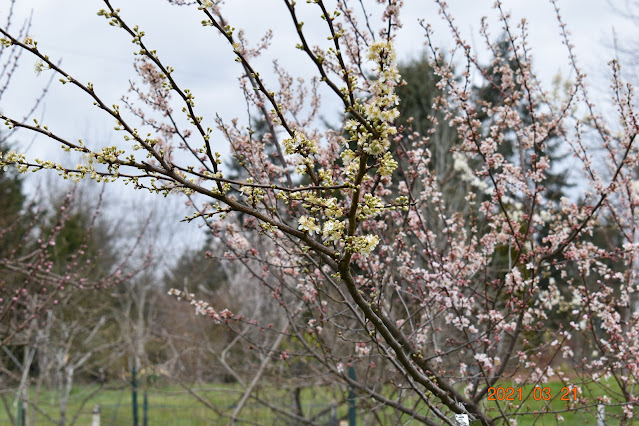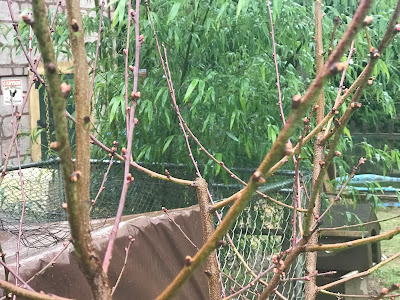Didn't do much. Mostly did homework.
Noted one of the bearded irises has a rot disease. Didn't want to look too close at the others. Pacific NW rainy chilly weather.
Planted a 2nd batch of Four O'clocks seeds. The first batch has not germinated yet. I don't know how fast they are. First batch is at the battleground house. Coming home tonight, I forgot and left them outside. I don't know what the chilly nights will do. The first batch was from a Baker Creek packet. The batch I planted today was from a Burpee packet. Soaked for several hours, with a few changes of water. Soaking softens hard seed coat and for some plants removes natural germination inhibitors from the seed. Placed the containers on a seed starting heating mat.
Pollinated using paintbrush, plums, peaches, apricots.
Bloom order so far.
1. Prunus cerasifera "Crimson spire". About 2 weeks, now dropping petals.
2. Hybrid plum "Methley". About 2 weeks, now dropping petals.
3. Peach "Oregon Curl-Free". About one week.
4. Peach "Charlotte". About one week.
3. Hybrid plum "Satsuma". A few days.
4. Unknown Asian plum variety. Started yesterday.
5. Apricot trees, grown from seeds. Started yesterday.
At the Vancouver place, Shiro and Hollywood plums, genetic dwarf peaches, and peach-plum hybrid Trilite are in full bloom. Vancouver is a little warmer, maybe a week ahead of Battleground.
Toka plum is on the verge of blooming. The new peach tree, Q-1-8, is yet to show signs of life. The peach, Indian Free, may have one or two flowers. I think the others must have been freeze killed. There are leaves sprouting so I know it's alive.
The sweet cherry and Duke cherry buds are much bigger, compared to the tart cherry buds.
The gage plum buds are rounding up. The Stanley plum buds don't look like flower buds, but neither did those of the unknown Asian plum.
These bloom times correspond to what is blooming now: Jetfire daffodil, Dutch Master daffodil, dandelions' first flowers, Anemone blanda, some unknown narcissus varieties.
Other phenology, the lilac buds are size of mouse paws, like tiny clusters of grapes. The earliest of the pear flower bud clusters are apparent, but probably a few weeks from opening. Sourwood buds are barely visible. Linden buds are swelling.
from this, I'm thinking Crimson spire and Methley can pollinate each other and maybe Satsuma. The unknown plum and Toka can likely pollinate each other. There is some overlap between those and Satsuma. I don't know if plums, peaches, apricots can help one another when it comes to pollenizing - there are some artificial hybrids, but that may be very rare. Maybe.
Raintree gives Shiro blooming before Hollywood, but in my yard Hollywood was a few days ahead of Shiro. It does give Methley as the first, also my experience. They don't mention prunus cerasifera, which is sold as an ornamental. It's not just the climate. Rootstock may also be a factor. They also list Hollywood as self fertile, and Shiro as partially self fertile.
In one
old research paper, mixed pollen from diverse prunus species was more effective at producing pollination than that from a pure pollenizer, even if the chromosome number was different. Here is the table from their paper:
| Pollen mixture | Number of hybrids of type: | Total |
Sand cherry
x myr. plum | Sand cherry
x blackthorn | Sand cherry
x dom. plum |
| Myrobalan plum + blackthorn | 71 | 8 | - | 79 |
| Myrobalan plum + dom. plum | 37 | - | 1 | 38 |
| Blackthorn + dom. plum | - | 2 | 0 | 2 |
| Myrobalan plum + blackthorn + dom. plum | 2 | 63 | 1 | 66
|



















































